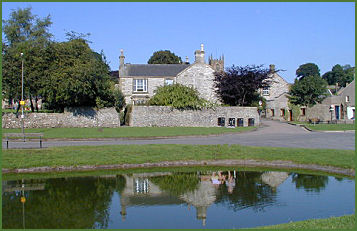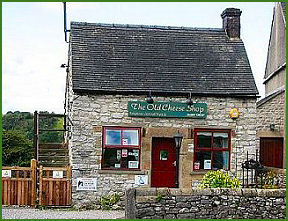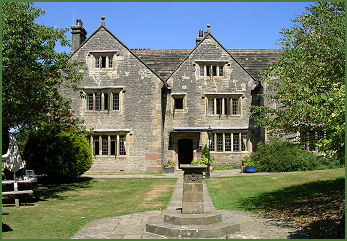Hartington
OS Grid ref:- SK129604
 The picturesque Peak District village of Hartington lies on the River Dove near to the Derbyshire-Staffordshire border. Now a popular tourist destination, it was formerly famous for cheese-making. The village's derives from the Old English for 'Stags' hill'.
The picturesque Peak District village of Hartington lies on the River Dove near to the Derbyshire-Staffordshire border. Now a popular tourist destination, it was formerly famous for cheese-making. The village's derives from the Old English for 'Stags' hill'.
The village is recorded in the Domesday Book, when it was owned by Henry de Ferrers and was then worth 40 shilllings. Henry de Ferrers possibly built nearby Pilsbury Castle around 1070 or 1080 as a wooden motte and bailey castle. The village remained in the hands of the de Ferrers family untill 1266, when it was confiscated from Robert de Ferrers III, Earl of Derby, as punishment for his part in a rebellion against King Henry III. It then became part of the estates of the Duchy of Lancaster.
 The medieval village church of Saint Giles stands proudly above the market square and dominates the village, the building dates back to the thirteenth century and boasts a two-storey porch, a cruciform transept and aisles dating mainly from the thirteenth and fourteenth centuries. The Perpendicular tower is a fifteenth century addition.
The medieval village church of Saint Giles stands proudly above the market square and dominates the village, the building dates back to the thirteenth century and boasts a two-storey porch, a cruciform transept and aisles dating mainly from the thirteenth and fourteenth centuries. The Perpendicular tower is a fifteenth century addition.
The building underwent a major restoration by Norman Shaw in 1873. A medieval effigy of a lady, thought to be Margaret de Ferrers, Countess of Derby, dating from the early thirteenth century, was discovered during restoration work on the church and only the head and feet are on display. Medieval wall paintings inside the church depict the twelve tribes of Israel.
 Hartington is centred around a spacious square, with a pond as a focal point. Seventeenth century Hartington Hall (pictured left) now serves a youth hostel. The hall was built in 1611 by Hugh Bateman and substantially aextended and extended in 1862 by Thomas Osborne Bateman. The building was opened as a youth hostel in 1934. There is a restaurant on the site, which is open to the general public. It also has an adventure playground and a pets' area. Tradition states that Bonnie Prince Charlie stayed at the Hall during the ill fated Jacobite rising of 1745.
Hartington is centred around a spacious square, with a pond as a focal point. Seventeenth century Hartington Hall (pictured left) now serves a youth hostel. The hall was built in 1611 by Hugh Bateman and substantially aextended and extended in 1862 by Thomas Osborne Bateman. The building was opened as a youth hostel in 1934. There is a restaurant on the site, which is open to the general public. It also has an adventure playground and a pets' area. Tradition states that Bonnie Prince Charlie stayed at the Hall during the ill fated Jacobite rising of 1745.
The former creamery in the village, often called the cheese factory, was established by the Duke of Devonshire in the 1870s, it was one of the three sources of Stilton, and also produced its own unique Dovedale cheese and others such as Buxton Blue cheese. The factory was closed in 2009. The cheese shop (pictured above right) associated with the factory has re-opened under private ownership.
Hartington Mill, situated by the River Dove, was the local water mill for grinding corn, it is now a private house. The village has several pubs, including the Charles Cotton Hotel in the village square, named for the companion of Izaak Walton, who was born at nearby Beresford Hall. There are also a number of tourist shops and a public car park.
Nearby places of interest
Dovedale a dramatic limestone ravine, with its impressive rock outcrops and tranquil woodlands is arguably the prettiest and most famous of the dales in the Peak District National Park
Beresford Dale Picturesque Beresford Dale, which forms part of the Dove Valley, is a delightful miniature version of the nearby popular Peak District beauty spot of Dovedale.
Arbor Low Stone Circle sometimes referred to as ‘The Stonehenge of the North' and a prehistoric site of unique archaeological and cultural interest.
Ilam Country Park is situated at the Peak District village of Ilam to the north west of Ashbourne. The park covers 158 acres (0.64 km2) on both sides of the River Manifold.
